
Want to learn more? This National Geographic Book on Owls is a great read!
The most common of these owls to be seen in Pennsylvania is the Great Horned Owl. This is no surprise as the Great Horned owl is one of the most widely spread and abundant owl species across all of North America.
The state of Pennsylvania has a continental climate with humid seasonal weather. This state has 121 different state parks and 19 different national parks.
Now that we’ve discussed a little about Pennsylvania and the owls that can be seen there, lets have a look at these wonderful owl species in more detail.
Want to attract Owls to your yard? Take a look at our article!
What Owls can be seen in Pennsylvania?
Table of Contents
1. Barn Owl
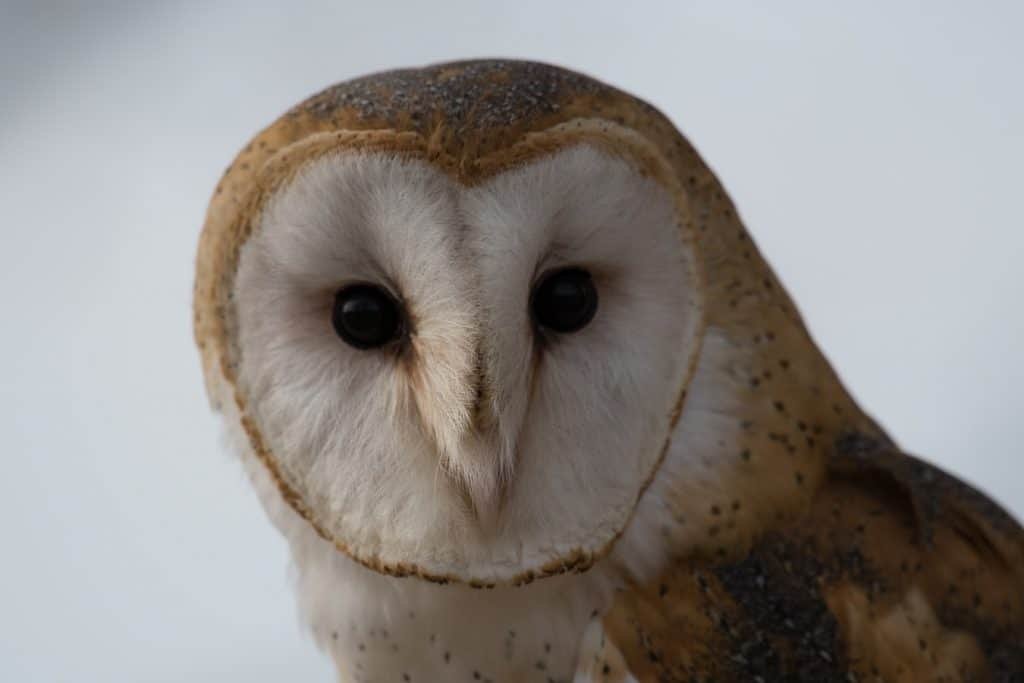
Wingspan
107 to 110 cm
Weight
430 – 620 g
Life Expectancy
Up to 4 years
Diet
Voles, Shrews & Mice
The barn owl is a common species of owl. Its feathers are pale brown with buff on the tips.
Its belly is covered in bright white feathers and in certain lights this can make the owl appear completely white. They can be seen across 48 different states and are most commonly found in open grassland areas.
The females will make the nests for the eggs and, unlike a lot of birds, barn owls will use these nests as roosts throughout the whole year. These nests will be used in subsequent years, sometimes by different owls.
Barn owls will often mate for life and remain monogamous during breeding seasons. That being said, there have been recorded instances of Barn Owl males mating with more than one female at a time.
These birds are permanent, year-round residents in the state of Pennsylvania.
They can be seen throughout all of the state and are most active during the breeding seasons.
Most of the recorded sightings are in the southern regions of the state.
2. Eastern Screech Owl
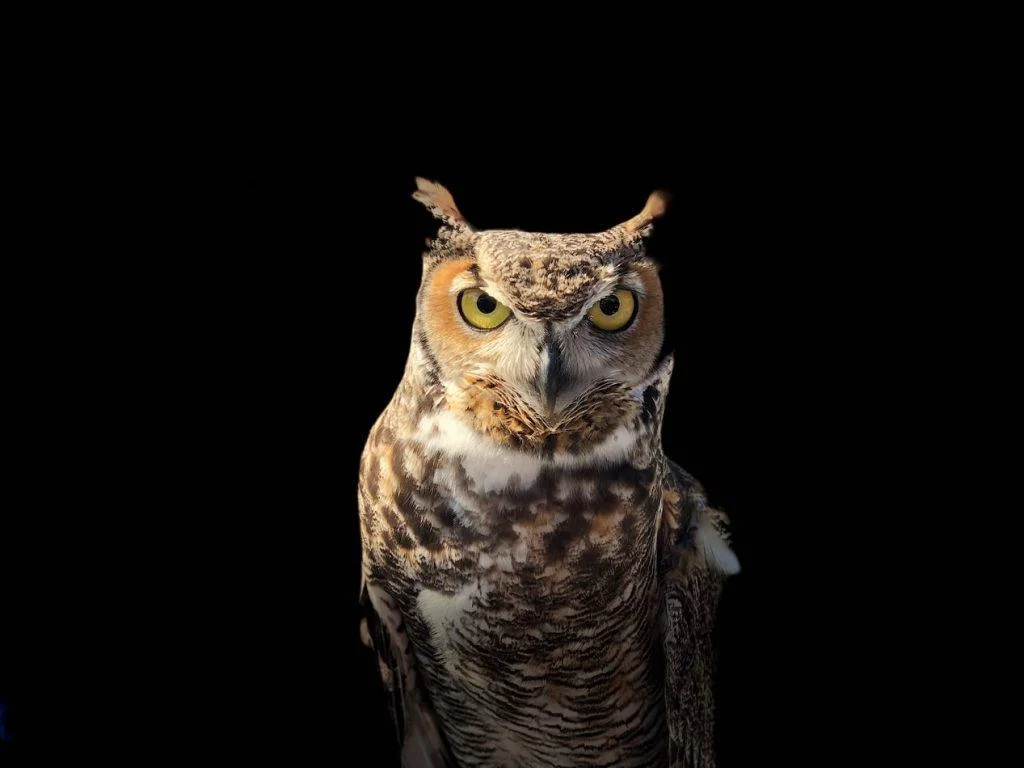
Wingspan
46 to 61 cm
Weight
160 g
Life Expectancy
14 years
Diet
Rats, Squirrels, Rabbits & Skunks
The Eastern Screech-Owl has a unique pattern of grey feathers that help it to camouflage against trees and it has sharp distinct ear tufts.
These owls are not particularly fussy about where they habituate, any area with dense enough trees will suffice.
That being said, they have also been observed nesting and successfully breeding in more suburban areas and city parks.
Males are very defensive of their territories and they form stable breeding pairs with either one or two females.
Both of the individuals in the mating pair will help to raise the young and males will bring food to the female nursing the fledglings.
As expected, the range of this owl is largely restricted to the eastern states of north America.
Because of this it is a year-round resident of Pennsylvania and can be seen throughout all regions of the state.
There appears to be a similar number of sightings across all areas of Pennsylvania.
3. Great Horned Owl
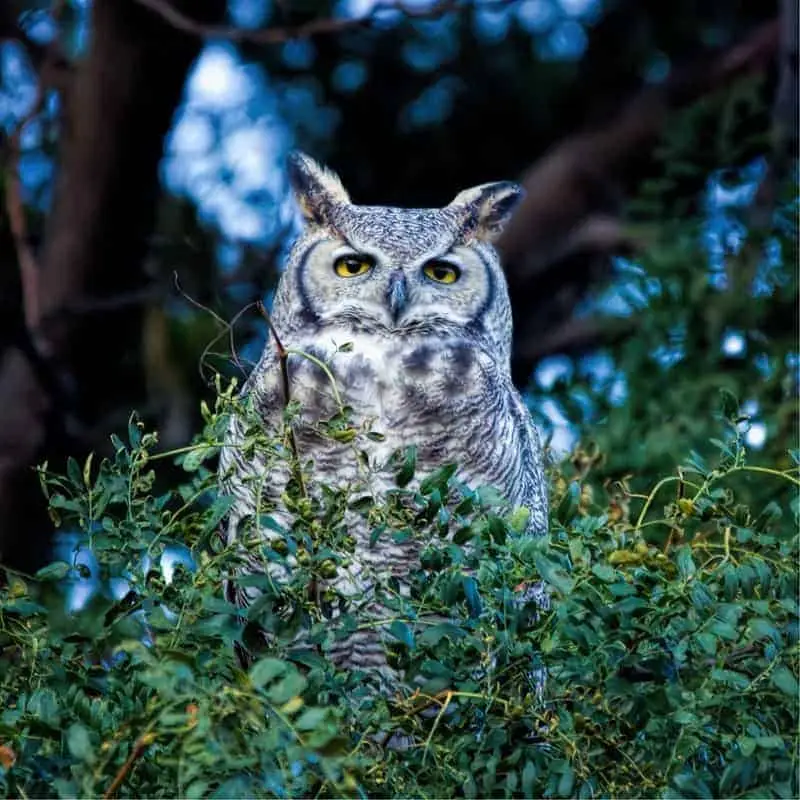
Wingspan
~140cm
Weight
1.4 kg
Life Expectancy
28 years old
Diet
Squirrels, Rabbits & Skunks
This owl is possibly the most common owl throughout all of the United States and it does not, despite the name, have horns.
Instead it has long pointed ear tufts that create a what looks like horns when silhouetted.
These owls have a wide range of habitual areas across the state but are most commonly found in coniferous woodlands and mixed woodland areas. Great Horned Owls form breeding pairs that remain monogamous throughout the breeding season.
Both individuals in the pair are territorial animals and will both act to defend their territory and their eggs. They will do this by performing a series of vigorous hooting.
With their incredibly wide range it is no surprise that these owls can be seen throughout all regions of Pennsylvania.
They are also permanent residents in the state and they are most active in early winter when they are getting ready for the breeding season.
There seems to be an even distribution of this owl throughout the state.
4. Northern Saw-whet Owl
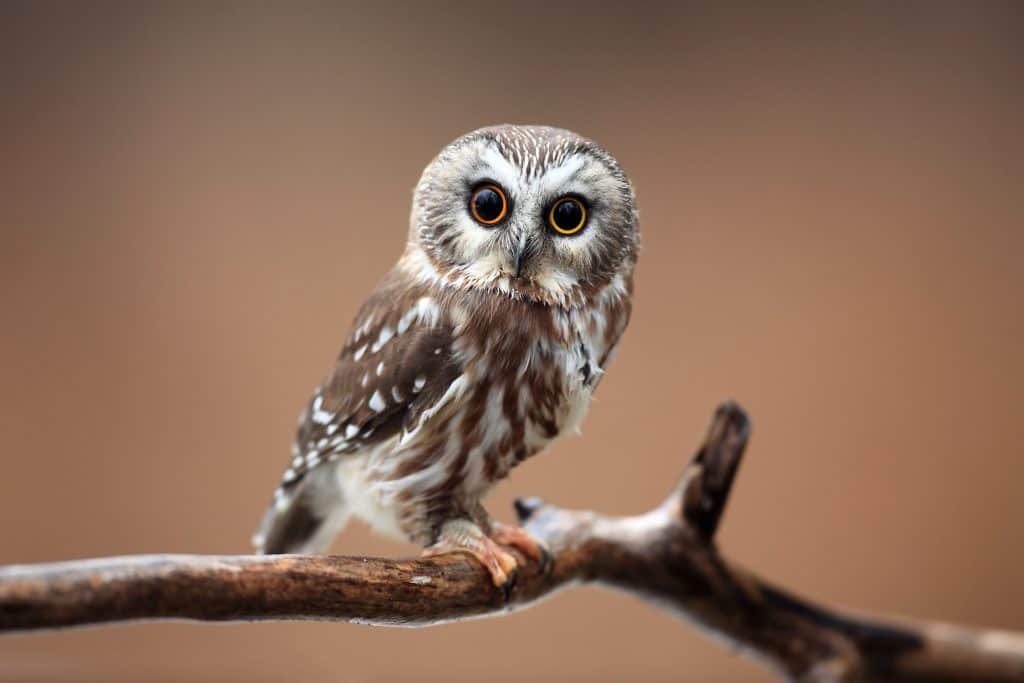
Wingspan
40 - 60 cm
Weight
100 g
Life Expectancy
7 years
Diet
Small birds, young squirrels, voles & shrews
The Northern Saw-Whet Owl is known for its big round head and wide orange eyes and they are very small in size for an owl.
Their wings are covered in brown feathers and their backs have similar colour patterns. Contrasting this their bellies are bright white.
These birds will almost always nest in dense forests, they seem to prefer staying in mature forests if they are able to.
The density of the forest is more important when it comes to the breeding and winter seasons. Whilst most males are completely monogamous, in seasons of high prey abundance, some males have been known to mate with another individual.
This appears to be the only thing that affects the monogamy of this owl. However, they do not mate for life and new breeding pairs will be formed in each subsequent breeding season.
Because of their small size, these owls are also often preyed on by a variety of larger owl species, including several that we have previously looked at in this article.
These birds are year-round residents of Pennsylvania, but only in the north west.
In the other regions of the state, you can only see these birds outside of their breeding seasons when they expand their hunting ranges.
There appears to be an even distribution of sightings of this bird across Pennsylvania.
5. Short-Eared Owl
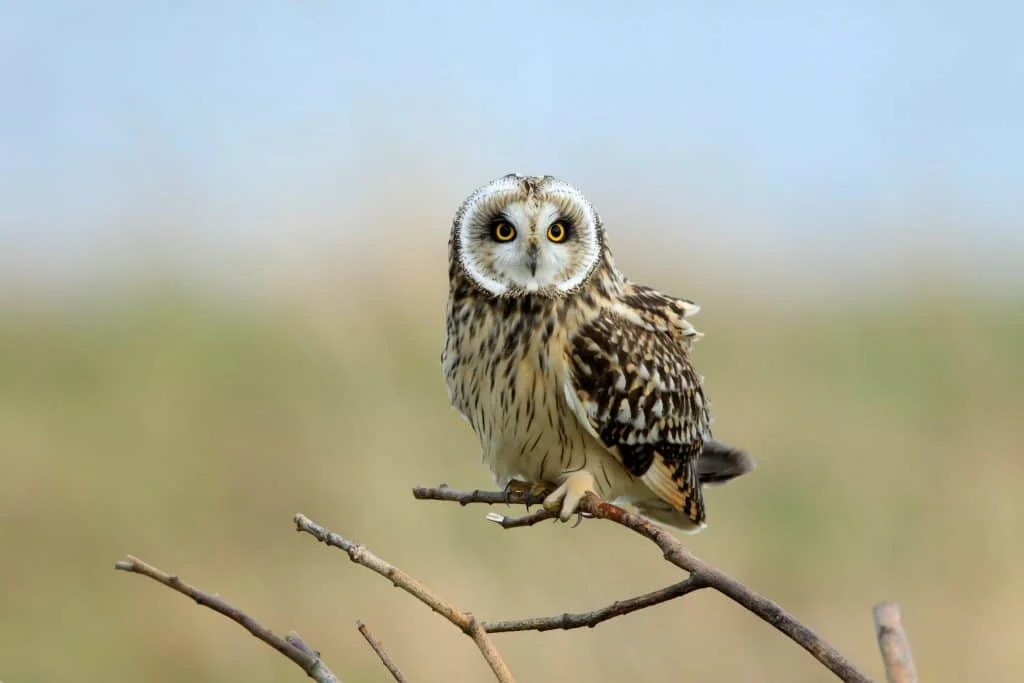
Wingspan
85 to 110 cm
Weight
206–475 g
Life Expectancy
4-12 years
Diet
Voles, Mice, Squirrels
Whilst you cannot see this owl’s ears, it is appropriately named as it has ear tufts that are so small that they cannot be easily seen.
These owls have brown feathers spotted with buff that cover all of their bodies and are average sized for an owl.
You are most likely to see this owl in large areas of open grasslands. These owls have been recorded to be active at all hours of the day and night when it reaches the breeding season.
They will spend a lot of the day time doing courting displays for females so will use the night to do some extra hunting.
The male’s primary role after mating is to protect the female whilst she incubates the eggs.
They will do this by performing distraction displays to intruding individuals to deter them away from their nesting site and this is often done to animals of much bigger size.
The range of this owl encompasses all of Pennsylvania but when you can see them depends on the region.
In the northern areas of the state, some of these owls will make their permanent nests there whereas in the more southern regions, there are only likely to be these owls present outside of the breeding seasons.
6. Snowy Owl
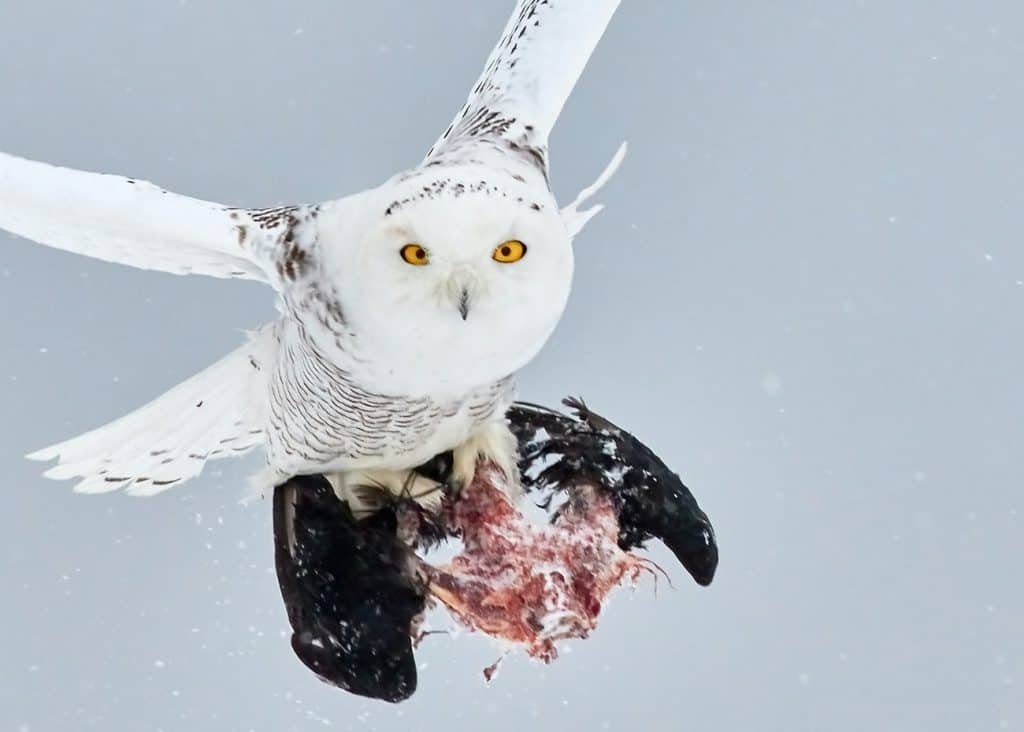
Wingspan
150 cm
Weight
2 kg
Life Expectancy
10 years
Diet
Birds, Rabbits, Fish & Rodents
The Snowy Owl is one of the most commonly known owls because of its distinct snowy white feathers.
These medium sized birds are most commonly found in the tundra habitat and can be incredibly aggressive when defending their territory.
There has not only been recorded incidents of Snowy Owls diving at humans that get too close, but there has also been a record showing a pair of these owls attacking an artic wolf to defend their territory.
Males will court the females by performing a flight display before dropping a prey item, such as a lemming, before her.
Apart from that not much is known about the breeding behaviour and there is speculation as to whether they are monogamous and form breeding pairs that mate for life.
The range of these owls does not extend far into the United States as they stay in arctic areas.
But they do go to Pennsylvania during the winter months when it is too cold further north.
Even then they can only be seen in the most northern regions of the state.
7. Long Eared Owl
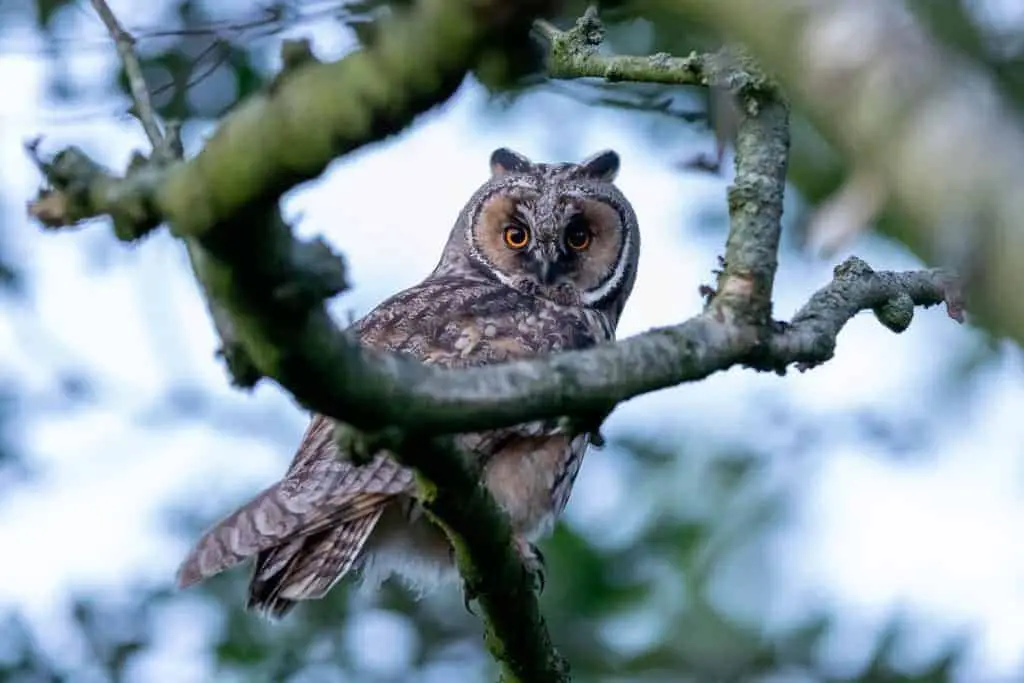
Wingspan
90 to 100cm
Weight
250 g
Life Expectancy
4 years
Diet
Small mammals, mice, rats & rabbits
These owls are easily identifiable by their long, pointed ear tufts which is also why they have their accurate name.
These medium sized owls have stout bodies covered in dark feathers and orange faces.
This owl can be found in both open grasslands and coniferous woodlands, usually the larger the area, the better.
These birds have been known to form loosely structed colonies that often make which can reach a number of 100 individuals outside of the breeding season.
During the breeding season this number decreases but they still roost about 50ft away from each other.
Males remain monogamous and begin courting a female during the late winter, before the colonies are fully formed.
There is speculation as to whether these breeding pairs are long-term or if a male will mate with a different individual from the colony in subsequent seasons.
These owls have a very large range but due to their behaviours and migratory patterns they can only be seen in Pennsylvania outside of their breeding seasons.
They have been recorded in all regions of the state, but the most common number of sightings are to the north west of the state.
They appear to be less common in the central regions of Pennsylvania compared to other areas.
8. Northern Hawk Owl
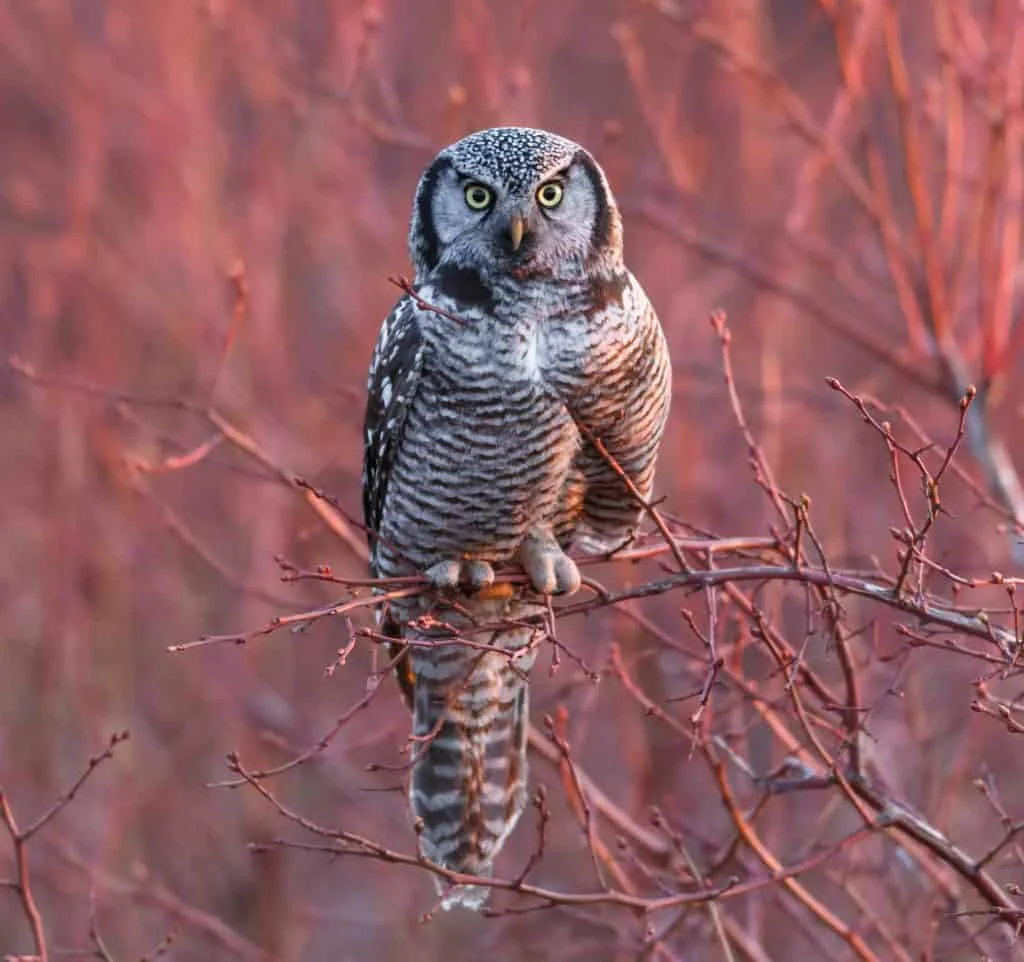
Wingspan
45 cm
Weight
300 -340 g
Life Expectancy
Up to 16 years
Diet
Rodents & Small Mammals
The underbelly of this owl is covered in brown and white striped feathers whilst its back is covered in dark feathers of grey and black.
This bird is most commonly seen in either coniferous or mixed woodlands, quite often these woodlands will be close to swamp areas as well.
Their main requirement is that the area has a good selection of perches.
These birds are solitary apart from the breeding season and when they mate they will only stay together for a singular breeding season.
During the beginning of the breeding season when a male is trying to court a female, he will not leave his territory and will only hunt within the territory boundaries.
Whilst they are quick to act aggressive to species such as humans coming too close to their territory, they appear happy to let others of their species pass through their territory or roost nearby.
These birds have a range that is largely to the north of the United States but they have been seen in Pennsylvania.
These sightings have only been to the far north of the state and they are only in Pennsylvania during the winter months.
9. Barred Owl
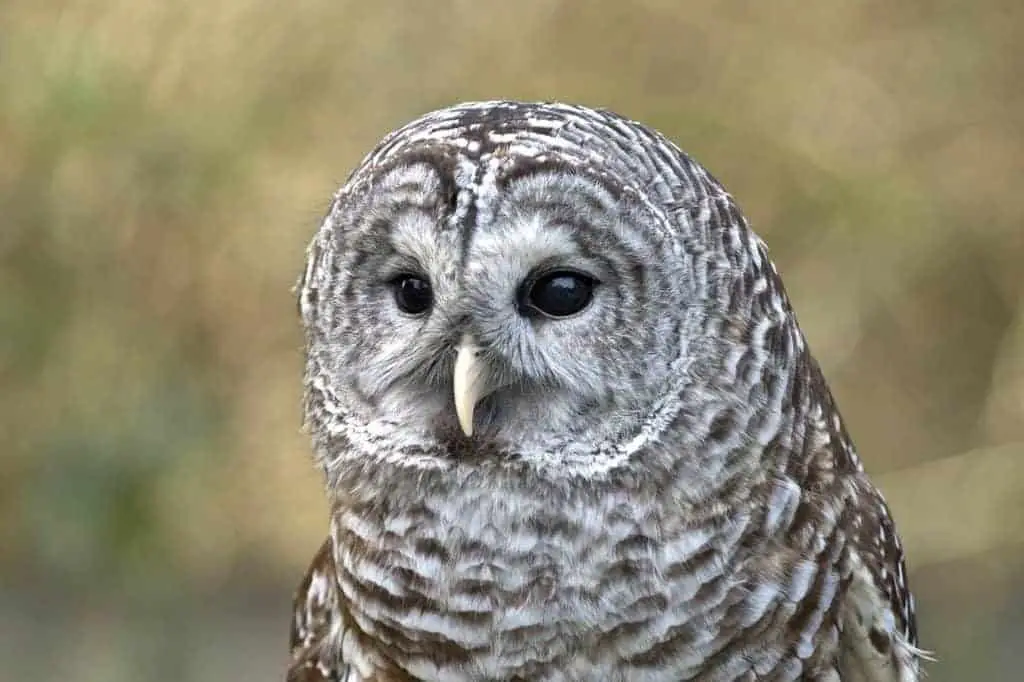
Wingspan
96-125 cm
Weight
468-1,150 g
Life Expectancy
10-23 years
Diet
Small mammals
The Barred Owl has distinct bar patterned feathers that cover its body which is where it gets its name.
These bars are usually brown and white in colour and are most obvious on the belly. Their habitats are usually close to areas of water and include a variety of woodlands.
These areas can range from swamps to coastlines. Barred Owls will roost in the daytime and will only hunt at night.
Barred Owls are common prey for a variety of species including the aforementioned Great Horned Owl, though they are predators to a lot of smaller bird species, such as woodpeckers.
If a human moves in too close to a Barred Owl’s nest they have been known to sometimes attack or flee, leaving their nest and eggs to be mobbed by smaller species of birds.
These birds have a range that spans across the north eastern states, including Pennsylvania.
They are permanent residents in the state and can be seen across all regions.
The highest number of recorded sightings of this bird are to the west of the state, close to the border with Ohio.

More Articles.

35 Best Flowers for Attracting Hummingbirds
If you’re trying to attract hummingbirds to your garden or home front, it can be

What Does It Mean To See a White Feather Fall in your Dreams? (Symbolism and Meaning)
In some cultures, seeing a white feather fall in your dream is a sign of

How To Attract Birds To A Balcony?
The best way to attract birds to a your balcony is to choose the correct

About Us
We are avid bird-watchers who recently retired, allowing us more time to travel the world. Fortunately, we have managed to visit numerous countries around Europe, Asia, and America. Watching and photographing birds has been a passion for many years and we are making the most of the extra time on our hands!
